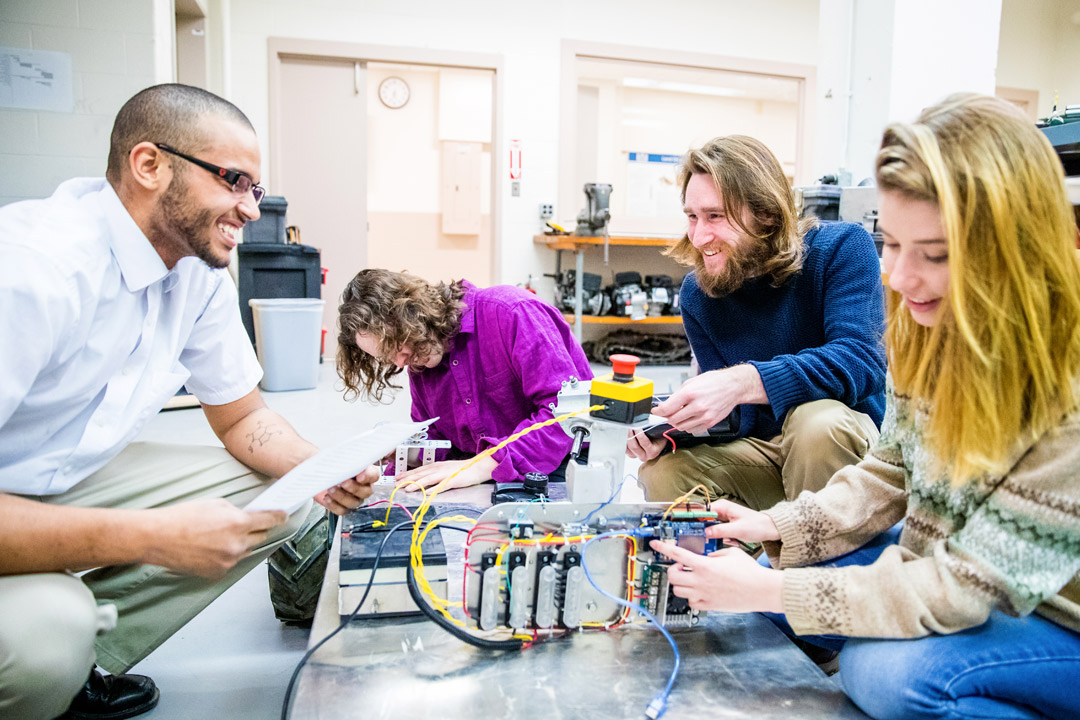
We updated this article with new class activities. The article was originally published in September 2017.
How can you bolster and maintain student engagement throughout your course? If you’re in search of ideas, we’ve curated a collection of cutting-edge class activities used by VentureWell Course & Program Grants recipients. These class activities are designed to prepare early-stage innovators in taking the first steps toward transforming their ideas into impactful inventions and ventures.

1) The “If I Knew…” Exercise
Aileen Huang-Saad
University of Michigan
“Each term, I end the class with the “If I knew” assignment. Students are asked to fill out a simple PowerPoint template that asks the following questions:
- When I signed up to take this class, I was expecting…
- This is what I got out of the class…
- If I had only known…
- This is what I would change…
Before class, I go through all of the student responses and aggregate the feedback into the themes. I then present the summary to the students for the last class and we discuss their reflections. This summary presentation is then used to iterate on the course for the following year and is assigned as the first reading for the next cohort of students as their first assignment. This sets the stage for the next class.”

2) The Envelope Exercise
Pritpal Singh
Villanova University
“I like class activities like the envelope exercise developed by Tina Seelig at Stanford University. In this exercise, the students are asked to plan for a two-hour activity to increase an initial, unknown investment provided to them in an envelope. The amount of money in the envelope is very small – around $2. The students are usually surprised at how little money is in the envelope. Yet, every time I’ve done this exercise, the students have increased the investment money provided to them. The exercise helps students realize how easy it is for them to make money. I was particularly delighted when the students at the Bluefields, Indian, and Caribbean University in Nicaragua came to this realization. These students are generally from relatively poor communities and lack confidence in their ability to make money. When they performed this exercise and realized how easily they could make money, it was really eye-opening and thrilling for them. It was also a very rewarding experience for me.”

3) The Get Out of the Building Exercise
Rodney Boehm
Texas A&M University
“I provide exercises that get students out of the building. Nothing shapes a student’s perception about their idea or market better than talking with a customer. Most students are uncomfortable when they start a conversation with a potential customer. Once they are comfortable with the skill, it transforms them and their way of thinking.”

4) The Pure Imagination Exercise
Laquita Blockson
Agnes Scott College
“During the second week of my introductory entrepreneurship courses, I conduct a team exercise to convey the importance of creativity. I first show my students the “Pure Imagination” scene from the 1971 film Willy Wonka and the Chocolate Factory, asking them to listen carefully to the lyrics. This prepares them to think beyond normal convention during the exercise. I then provide each team with a common household item—a clothespin, a pill bottle, a cotton t-shirt, for example—and instruct them to think of alternative uses for their item. Once the teams have identified ways their item can be repurposed, I encourage them to contemplate how to deconstruct and reconstruct each item to make it more user-friendly. I find this exercise particularly useful because many of my students are not business or engineering majors, so by inspiring them with a film that they have likely seen, and by using common items, they are able to better internalize the connection between creativity and entrepreneurial opportunity.”

5) The Defining Problems Exercise
Ruth Ochia
Temple University
“In my introductory course, I work on students developing a sense for defining problems. I show pictures that contain many potential issues. The students are asked to define the issues they can see and what questions they would ask or additional information they would want to help define the problems. They always want to start with solutions, but the key is to get them to define the problem better, which is half the work of solving the problem anyway.”

6) The Flipped Classroom Exercise
Deb Streeter
Cornell University
“I think almost all entrepreneurship professors use class activities to create what is now considered to be a “flipped classroom.” I’m no different. Students in my courses work to develop business ideas and concepts, go out to understand customers, pivot, pitch, and spend time outside the building to learn and practice Lean Startup concepts. I also try to spark interesting conversations inside my classroom. Sometimes I do that by using short, focused video clips or the Startup podcast. I use the mishaps and adventures featured in the podcast to illuminate important ideas and concepts. The episodes are a perfect match with so many concepts related to entrepreneurship and Lean Startup. The class becomes very invested and opinionated about the founders and the company.”

7) The Business Thesis Exercise
Jed Taylor
University of Illinois at Urbana-Champaign
“There is a simple business thesis exercise that we use in our I-Corps program that teaches teams to articulate their value proposition and customer segment in a concise way. It sounds simple, but it always amazes me how challenging it is for students to do at first. I even crack out this exercise every time that I give a guest lecture across campus.”

8) The Soft Skills Exercise
Cheryl Bodnar
Rowan University
“I use game-based class activities to help students develop their soft skills such as oral communication and teamwork, both of which are critical for entrepreneurs. Each player has a card with various symbols on it, and only one of the symbols on their individual card is defined. Without showing their cards to other players, participants have to decode the symbols and reveal the message on their individual cards, using only oral communication. The end result: all players enter a color on a rainbow-colored game board and the whole class wins.”

9) The Blindfold Exercise
Joe Tranquillo
Bucknell University
“In some classes I teach, I will hand out blindfolds and ask everyone to put them on. Then they pair up. Their task is to leave the second floor of the engineering building, navigate the campus, find the library, stand in line at the café and order a coffee or tea. The pair only gets to take off their blindfold when they get their beverage. Afterward we deconstruct this activity. The most important insight is that we as educators talk a lot about knowing your customer. Sometimes the only way to really understand a customer is to live in their world. After this activity the challenge is to find ways to become or simulate how to be your customer. Students seem to remember these class activities for a very long time!”

10) The Two-Minute Pitch Exercise
Christine E. King
University of California, Irvine
“I teach the students how to design websites and we train them how to perform two-minute pitches. I love watching the students get excited about their project, and learn how to understand the big picture. These pitches are then presented at our final symposium to industry judges. We provide the winning team with funding and resources to start their company. Each year, we have 1 to 3 student teams form companies and continue to develop their venture beyond their degree. It creates such an exciting environment to teach in, as what we show them becomes applied immediately into their careers.”
For many student inventor entrepreneurs, their first exposure to innovation and entrepreneurship happens in the classroom. That’s why it’s important to continuously develop and improve upon innovation and entrepreneurship class activities to ensure early-stage innovators are well-equipped to solve the world’s biggest problems. Learning curriculum development ideas and best practices from other faculty in the ecosystem can help educators adopt, implement, and refine their own coursework for maximum impact.

11) The Value in Waste Exercise
Taryn Mead
University of Arkansas and Western Colorado University
“I teach about various topics related to the circular economy, including regenerative innovation, or the process of developing supply networks for new products using waste materials. With VentureWell’s support, I recently led a class—and later an innovation challenge—in which students had to develop a product and business model to turn waste into new products. The teams have come up with great concepts, and some of them are going to apply for business accelerator programs at the state level.”
Editor’s note: Learn more about Taryn’s work using the waste stream in the classroom.

12) Life Cycle Analysis for Sustainable Engineering Design
Nancy Ruzycki
University of Florida
“In my exercise, students track an object through its life cycle to understand its impact all along the product journey. This is especially eye-opening for materials engineers, who might not have considered the impact of their materials choices. This gives them something to think about as they move into an engineering design career and start making decisions for a company. I love the life cycle analysis for the impact it has on students in their understanding of engineering materials selection.”
Editor’s note: For more information on materials choices, check out our Tools for Design and Sustainability.

13) The How Might We… Mini-Design Challenge
Carlee Bishop
Agnes Scott College
“We kick off our Human Centered Design (HCD) course with a mini-design challenge to introduce students to the design process and products. This helps students focus on a larger course project that addresses how to create a sustainable, human-centered intervention in the agriculture space. Our philosophy is to establish a learning environment for students to learn HCD by doing HCD.”
You might also like these blog articles with example class activities you can use:
6 Virtual Classroom Exercises To Keep Students Engaged
7 Class Exercises To Amplify Innovative Thinking
Activities for Teaching Innovation: Game-Based Learning
Curious to know more about our Course & Program Grants, which offer up to $30,000 in funding to faculty and staff? Learn more.